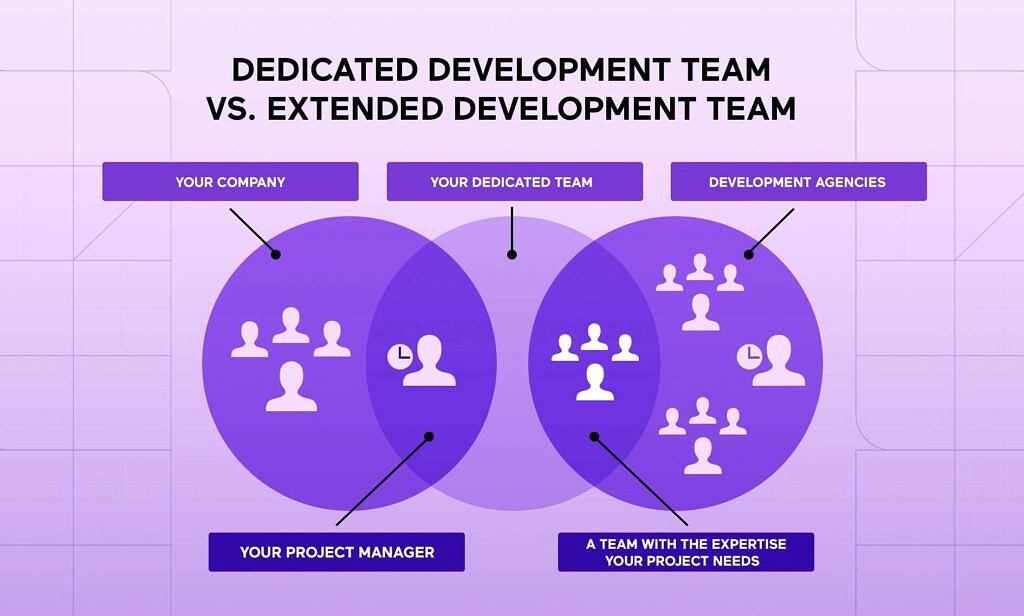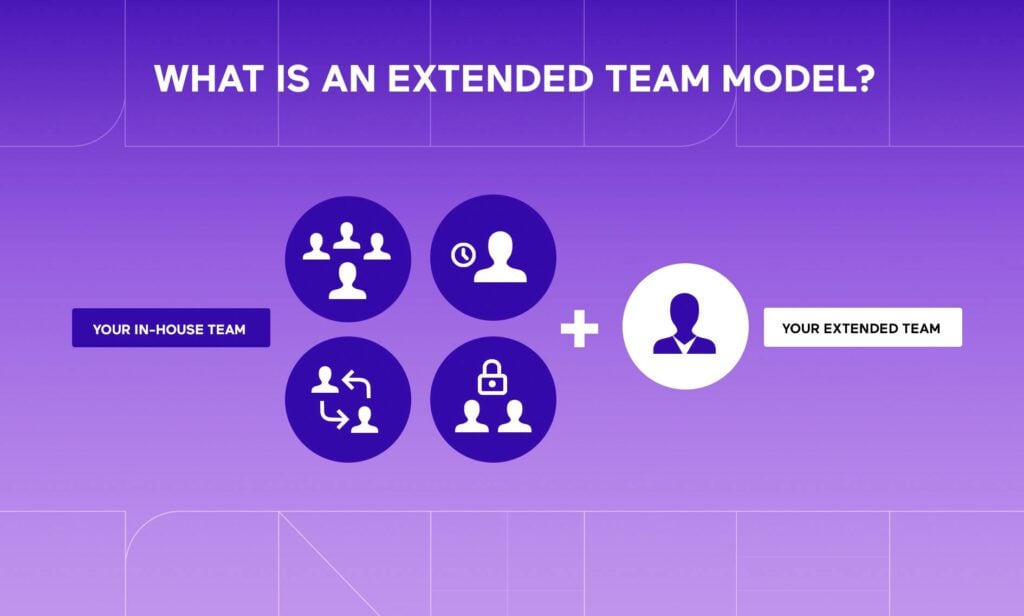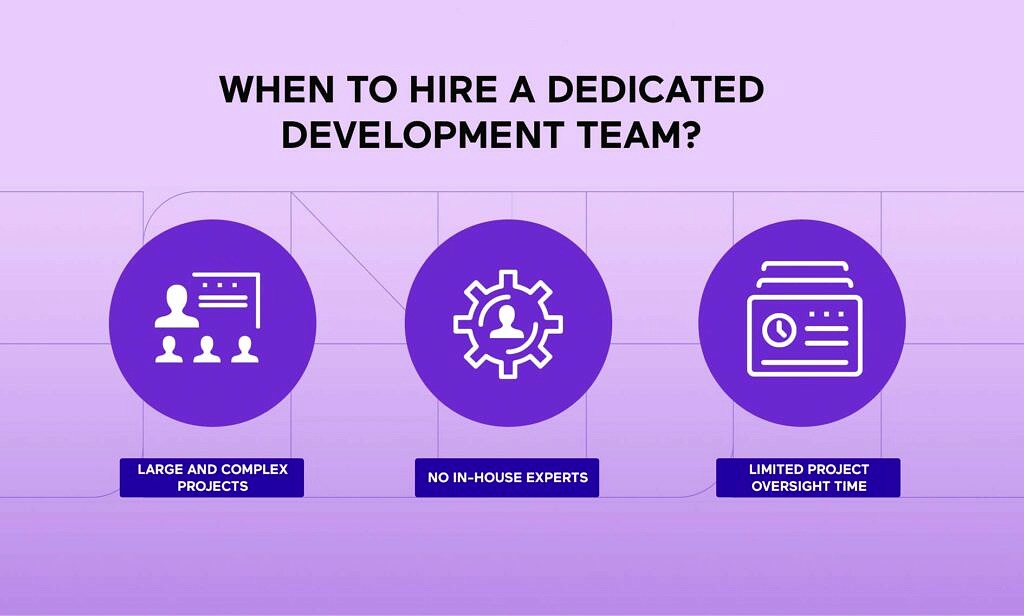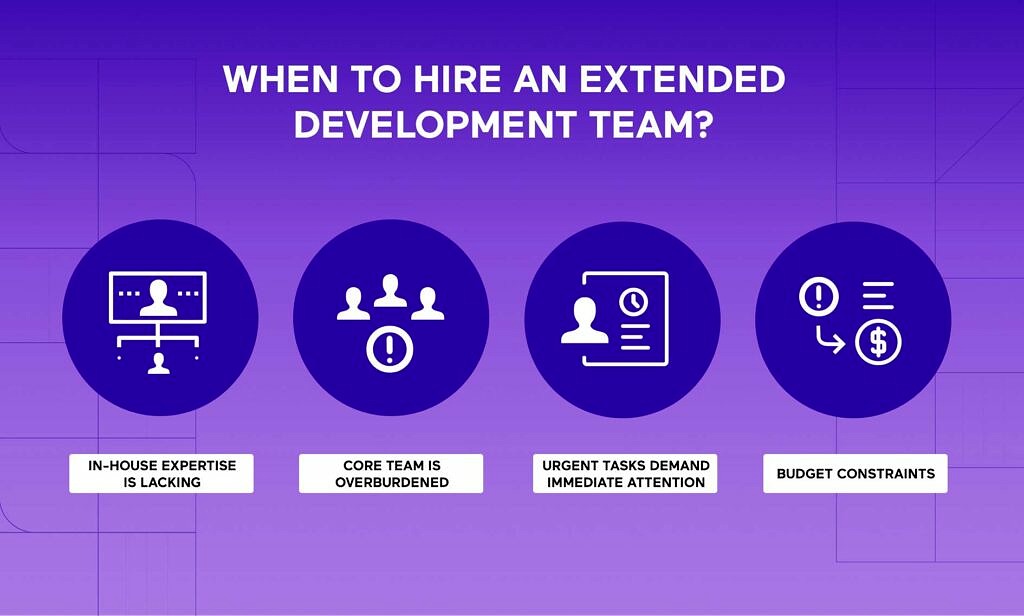Did you know that the worldwide IT outsourcing market is projected to reach $410.5 billion by 2027 and is growing at a CAGR of 6.2%? (Source: Grand View Research). Each day, it feels like the tech landscape is making huge leaps and changes that are requiring business leaders to increasingly consider and turn to outsourcing in order to bridge skill gaps and accelerate project timelines, especially in the world of AI where everyone is competing over the same talent. But with so many project staffing models available, choosing between a dedicated team and an extended team can be daunting. This guide will break down the core differences and help you make an intelligent decision that is tailored to your project and business’ unique needs.
That’s why outsourcing, outstaffing, and IT staff augmentation have become increasingly popular among organizations of all sizes. In fact, of the $92.5 billion in contracts generated by global outsourcing firms, $66.5 billion came from information technology (IT) services. Business process outsourcing made up the remaining $26 billion in total contract values.
To get the most out of your outsourcing budget, it’s important to choose the right staff augmentation model for extending your team. In this article, we’ll look at the two main organizational model options along with their pros and cons, and help you decide which one is best for your needs.
There are two basic models for IT outsourcing: dedicated software development team and extended development team.
What is a Dedicated Software Development Team?
A dedicated development team is a group of skilled software developers who work exclusively on a particular software project or set of tasks. The dedicated team model operates as part of your in-house team and is 100% focused on your projects and strategic initiatives. The service provider has all the dedicated personnel required to help you complete tasks and projects over an extended period of time.
A dedicated development team for hire is ideal for complex projects that:
- Are high-volume and have a long-term development timeline.
- Involve a variety of resources, such as web designers, project managers, and software testers.
- Require end-to-end engagement, from discovery and requirements gathering to testing and launch.
Dedicated Project Team Advantages and Disadvantages
Pros:
- The service provider will have an in-house project manager to orchestrate your projects, taking a majority of management responsibilities off your plate.
- The team is fully dedicated to your project, so you can expect a cost-effective and cohesive solution.
- It is a flexible, scalable, just-in-time solution that provides you with the necessary expertise and resources to meet specific needs.
- It helps you reduce overhead costs associated with hiring and HR while maintaining complete control over the quality of the output.
Cons
- Potential language, cultural, or time zone barriers if the dedicated team is located remotely.
- Due to the more extensive ramp-up time required, it’s not an efficient solution for short-term projects.
- When you hire dedicated development team members abroad, incremental management may be required to successfully communicate with them.
Dedicated Project Team Structure
The dedicated software development team is formed to perfectly match your project’s requirements, some of which are:
- Essential skills and qualifications: The Tech team should be carefully selected based on the specific technical demands of the project.
- Team size: The team should be scaled to match the project’s scope and complexity, ensuring optimal resource allocation and cost-effectiveness.
- Technical expertise: Team members should possess the specific skills and knowledge necessary to bring the vision to life.
Dedicated Project Team Structure Roles and Responsibilities
A dedicated development team structure not only contains web developers but also professional experts to complete a project.
- Project Manager (PM): Acts as the central hub of communication, ensuring seamless collaboration between both teams. PMs oversee the project’s lifecycle, from managing deadlines and workloads to assigning tasks and maintaining smooth progress.
- Business Analyst: Conducts a comprehensive analysis of both business goals and the project’s technical feasibility. This ensures the final product aligns seamlessly with strategic objectives and technical specifications.
- UI/UX Designers: Responsible for crafting an intuitive and visually appealing user experience. Their focus lies on identifying and resolving user pain points through design solutions, resulting in an attractive, user-friendly interface.
- Software Developers: Comprised of both front-end and back-end experts. Front-end developers build the user-facing aspects of the product, including layout, client-side programming, and performance optimization. Back-end developers handle the server-side functionality, contributing right from the planning stage to the final product launch.
- QA Specialists: Act as quality guardians, meticulously testing the application throughout the development process to identify and eliminate bugs. Their dedication guarantees a market-ready product free of technical glitches.
- DevOps Experts: Bridge the gap between development and operations, streamlining the entire software lifecycle. They collaborate with developers and QA specialists to establish efficient testing environments and ensure smooth deployment
This dedicated team structure fosters focused collaboration and expertise, propelling your software development project toward successful completion.
Understanding the Dedicated Team Model
A dedicated team model is a popular approach to outsourcing software development projects. In this model, a client contracts a team of developers to work exclusively on their project for a predetermined period of time. The team operates as an extension of the client’s in-house development team, with the goal of delivering high-quality software on time and within budget.
One of the key benefits of the dedicated project team model is that it allows the client to have a high degree of control over the development process. The team works closely with the client to understand the requirements and deliverables which can be easily integrated into the client’s existing development processes and tools. This allows the client to maintain a high level of transparency and accountability throughout the project.
The dedicated team model is particularly well-suited for long-term projects that require a high level of collaboration and communication between the client and the development team. It can also be beneficial for projects that require specialized skills or expertise, as the team can be tailored to meet the specific needs of the project.
However, it’s important to note that the dedicated team model is not always the best fit for every project. It can be more expensive than other outsourcing models, as the client is responsible for paying the salaries and benefits of the team members. Additionally, it requires a high level of trust and collaboration between the client and the team, as the team will be working closely with the client’s in-house team and may have access to sensitive information.
To determine if the dedicated team model is the right fit for your project, it’s important to consider the following factors:
- The duration and complexity of the project: The dedicated team model is best suited for long-term projects that require a high level of collaboration and communication.
- The skills and expertise required: If your project requires specialized skills or expertise, the dedicated team model allows you to select team members with the specific skills needed for your project.
- Your budget: The dedicated team model can be more expensive than other outsourcing models, as you are responsible for paying the salaries and benefits of the team members.
- The level of trust and collaboration required: The dedicated team model requires a high level of trust and collaboration between the client and the team, as the team will be working closely with the client’s in-house team and may have access to sensitive information.
Overall, the dedicated team model is a powerful tool for outsourcing software development projects. It allows the client to have a high degree of control over the development process and can be tailored to meet the specific needs of the project. However, it’s important to carefully consider the duration and complexity of the project, the skills, and expertise required, the budget, and the level of trust and collaboration needed before deciding if the dedicated team model is the right fit.
What is an Extended Software Development Team?
An extended development team is an extension of your in-house team. The resources are usually hired to perform non-core IT tasks or fill skill gaps. There’s typically a close partnership between the internal and extended teams.
This model is most effective for:
- Filling skill gaps, particularly for one-time needs.
- Ramping up development to meet an aggressive project timeline.
- Adding “muscles” to a project within short notice.
- Completing tasks that are backlogged.

Extended Project Team Advantages and Disadvantages
Pros
- It offers a nimble and cost-effective solution for adding resources to short-term projects or filling skill gaps in one-off tasks.
- It provides the temporary resources the in-house team needs to meet deadlines and milestones without adding overhead.
- It’s highly scalable so you can get the skillsets and resources as required by each project while keeping the cost down.
Cons
- Management resources are required to oversee the remote team and coordinate communication.
- Possible disruption when changes are made to core projects and the teams have to pivot.
- Potential communication and collaboration challenges may arise if the external resources are not in sync with the in-house team.
Understanding the Extended Team Model
In the extended team model, a client contracts a team of developers to work on their project, but the team is not dedicated exclusively to the client’s project. Instead, the team works on the client’s project in parallel with other projects for other clients.
One of the main benefits of the extended team model is that it allows the client to access a larger pool of talent and expertise. By working with an extended team, the client can tap into the skills and expertise of a larger group of developers, rather than being limited to a smaller, dedicated team. This can be especially beneficial for projects that require a wide range of skills or expertise, as the extended team can bring together a diverse group of web developers with different backgrounds and experiences.
The extended team model is also often more cost-effective than the dedicated team model, as the client is not responsible for paying the salaries and benefits of the team members. Instead, the client pays an hourly or project-based rate for the work completed by the team. This can make the extended team model a good fit for projects with a limited budget or for clients who are looking to reduce their development costs.
However, one of the main drawbacks of this model is that the team is not dedicated exclusively to the client’s project, which can lead to reduced accountability and transparency. Additionally, the team may not have as much time to focus on the client’s project as a dedicated team, which can impact the project’s timeline and deliverables.
To determine if the extended team model is the right fit for your project, it’s important to consider the following factors:
- The duration and complexity of the project: The extended team model is best suited for shorter-term projects or projects that do not require a high level of collaboration and communication.
- The skills and expertise required: If your project requires a wide range of skills or expertise, the extended team model allows you to access a larger pool of talent and expertise.
- Your budget: The extended team model is often more cost-effective than the dedicated team model, as you are not responsible for paying the salaries and benefits of the team members.
- The level of accountability and transparency needed: The extended team model may not provide the same level of accountability and transparency as the dedicated team model, as the team is not dedicated exclusively to your project.
The extended team model allows the client to access a larger pool of talent and expertise and can be a more cost-effective option than the dedicated team model.
Service Models Comparison: Difference Between a Dedicated Team and an Extended Team

The following table presents some of the similarities and differences between the dedicated and extended team models.
| Aspect | Dedicated Team | Extended Team |
|---|---|---|
Popularity | Often chosen by businesses seeking complete control over resources and processes. | Preferred by businesses aiming to augment their existing team with specialized skills. |
Applications | Ideal for long-term projects with a fully committed team. | Suitable for enhancing the existing team’s capabilities temporarily or for specific projects. |
Key Advantages |
|
|
Key Disadvantages |
|
|
Cost-Effectiveness | Cost-effective for long-term projects due to full team dedication | Cost-effective for short-term projects or when specialized skills are needed briefly |
Infrastructure | Typically provided by the hiring or outsourcing company | Infrastructure may be shared between the core and extended teams |
Training | Requires orientation and possible training in company-specific tools and processes | Requires integration with the existing team and understanding of project scope and tools |
Communication | Regular and direct communication with the team is expected | Communication may be more intricate due to integration with the existing team |
Flexibility | Limited flexibility as the team is entirely dedicated to one project | High flexibility with the ability to quickly adjust resources as needed |
Security | High security; you have control over security standards and protocols the team follows | Moderate security; while you can set some security practices, the vendor also plays a role in security, and you will be somewhat dependent on their practices |
Tools and Processes | You have control over the tools and processes used by the team | The extended team employs the tools and adheres to the processes of the existing team |
Agreements | Generally requires a long-term commitment due to the team’s dedicated nature | Can be either short-term or long-term, depending on project requirements and business needs |
How To Decide Which Software Development Model Is Right For You?
When to hire a dedicated development team?

Now we get to the big question—when does hiring a dedicated team make the most sense?
Here’s a quick rule of thumb:
- Large and Complex Projects: Large projects often come with a multitude of components, intricate features, and expansive requirements. Managing such complexity requires a dedicated and cohesive team with a shared vision and commitment. Dedicated teams are assembled to work exclusively on your project, ensuring that every aspect is given the attention it deserves.
- No In-House Experts: If your organization lacks in-depth development expertise, opting for a dedicated team is a wise decision. This often occurs when non-tech-savvy clients aim to develop custom solutions for their businesses. Statista reports that 46% of companies choose to outsource software development projects due to skill gaps in their in-house teams. Outsourcing to a dedicated team provides a cost-effective and streamlined alternative to building an in-house team from scratch.
- Limited Project Oversight Time: Dedicated teams are an ideal solution when clients have limited time for project oversight. A well-functioning dedicated team should be capable of progressing independently while keeping clients informed at regular intervals.
When to hire an extended development team?

Now let’s consider when it’s more advantageous to extend your existing team rather than commencing a new one from scratch.
Bringing in an extended development team makes sense when:
- In-House Expertise is Lacking: An extended development team is a valuable addition when your in-house team lacks the specific expertise required for the project. Augmenting your core team with specialists ensures that your project benefits from the necessary skills and knowledge.
- Core Team is Overburdened: If your core team is stretched thin due to multiple projects or urgent tasks, expanding your resources with an extended team can alleviate the pressure. It allows you to maintain high-quality work without overloading your core team.
- Urgent Tasks Demand Immediate Attention: When critical tasks require rapid execution, enlisting an extended team can provide the necessary agility. This ensures that urgent project elements receive the immediate attention they require.
- Budget Constraints: Extended teams offer a cost-effective alternative when budget constraints are a concern. Expanding your existing team is typically more cost-efficient than building a new team from scratch, making it a practical choice in economically challenging situations
Practical Scenarios: Dedicated Team vs. Extended Teams for Project Excellence
Scenario 1: Hiring an Extended Development Team
Imagine your organization is already in the midst of developing a larger product, such as launching a Minimum Viable Product (MVP). The project is well underway, but you’re facing an aggressive deadline. Your in-house team is talented but stretched thin, and you need additional team members to accelerate development and ensure the MVP’s timely launch.
In this scenario, an extended development team model becomes the optimal choice. By seamlessly integrating a specialized extended team into your existing project, you gain rapid access to the required resources. These skilled professionals complement your core team, allowing you to harness their expertise and experience to meet the tight deadline. This approach not only streamlines the development process but also ensures that your MVP reaches the market on schedule, giving your organization a competitive edge.
Scenario 2: Hiring a Dedicated Development Team
Now, consider a different situation. You’re a startup founder with a groundbreaking idea, but you’re working with a limited budget and don’t want to incur the overhead of hiring an in-house development team. You need to bring your vision to life and develop a prototype to showcase to potential investors and stakeholders.
In this case, a dedicated development team model is the perfect solution. By partnering with a dedicated team service provider, you gain access to a team that oversees end-to-end engagement. They take care of everything, from product discovery services to quality assurance software testing and launch. This comprehensive approach allows you to minimize overhead costs while ensuring that your startup’s prototype is developed efficiently and professionally.
The dedicated team takes ownership of the entire development process, ensuring that your vision is realized without the complexities of managing an in-house team. This model offers transparency, cost control, and the expertise required to transform your loose idea into a functional prototype, helping you secure the support and funding needed to propel your startup forward.
In both of these cases, the choice between an extended development team and a dedicated development team is guided by the unique demands of the project and the organization’s goals. Understanding the specific scenarios where each model excels is essential for making the right choice and ensuring project success.
What are Your Other Options?
There is no doubt that the dedicated and extended teams are some of the more popular outsourcing models, but there are several other models that can work well depending on your project needs:
- The Hybrid Models:
A Hybrid model combines the pros of both the in-house and the outsourced development teams. Within this approach, you can build and maintain core strategic functions internally while outsourcing some of those more specialized tasks. The blend offers flexibility around team management and cost controls, which makes it ideal for a project that requires both stability and specialized skills that a team does not have in-house.
- Outsourcing:
When you do a complete outsourcing of a project, this transfers the responsibility of an entire project or specific parts to an external service provider that requires them to deliver. We see this model work best for businesses looking to completely offload IT tasks to focus on core business functions, especially if they are not in the business of writing and maintaining software. Outsourcing can lead to significant cost savings and give businesses access to a larger talent pool, but it does require careful management to make sure that the team you select is aligned with your business goals and culture and that they treat the project as passionately as your team would.
- In-House Teams:
Those businesses building and maintaining an in-house team see the benefits of control over projects and development that align closely with the company’s internal processes and culture. While this requires significant investment in recruitment, training, and retention, it does build a dedicated environment that can quickly adapt to changes and internal demands.
Each of these models has its pros and approaches where it performs best, and each unique situation should be defined by your project requirements, budget, and strategic goals.
Summary
Picking the right model for your software development team structure is an important decision that can reverberate the further you go out in time. The right choose at the end of the day depends significantly on the specific requirements of your project and how your team is set up currently. For those projects that require focused, long-term collaboration and a deep understanding of the business, a dedicated team starts to become more ideal. The reason is that this model supports more stability and deeper engagement, which allows for more complete project ownership and a higher dedication to your project’s lifecycle from start to release. Looking at the other model, an extended team model is more suited for projects that need specific skills on a short-term basis, or when you need to scale up your current workforce without the overhead of full-time hires. There is a lot of flexibility in this model, which helps with managing dynamic workloads and completing projects with tight deadlines. Technical and non-technical leaders should really write down and consider their project’s scope, the expected timeline, and the complexity against these the pros and cons of these team structures to make sure there is alignment with their organizational goals and they have the optimal resource utilization. Learn more about our IT staff augmentation services at SpiralScout IT Staff Augmentation.



